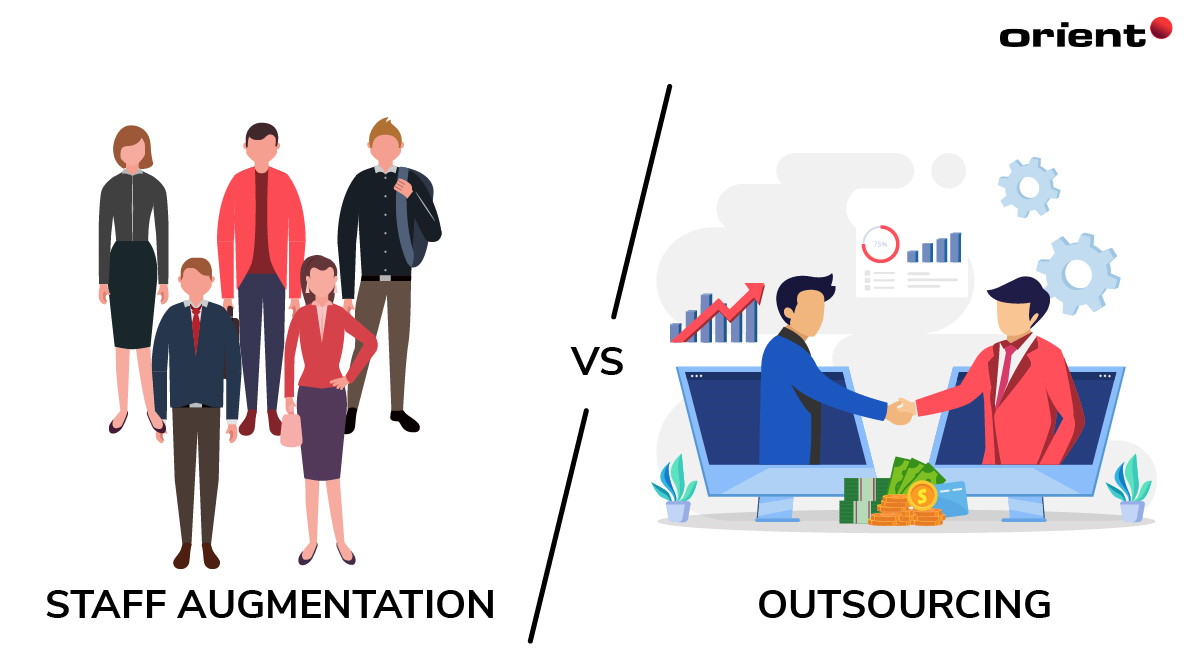
Staff Augmentation Vs. Managed Services: What's the Difference?

Content Map
More chaptersSo your business landed a new project? Congratulations! Have you gotten the right team on board to handle it yet?
If you haven’t, you are not alone. Man Power Group has reported that in 2023, 4 out of 5 businesses globally will experience problems recruiting qualified employees. As early as 2020, McKinsey noted that 87% of the respondents claim that skill gaps are occurring or are expected in the future. Building an experienced in-house team has never been an easy task. There are long hiring procedures and costs and bottlenecks.
So why not turn to IT outsourcing services? The market is projected to reach a value of US$777.7 billion with a revenue growth rate (CAGR 2023-2028) of 11.07% each year. Software outsourcing has long been known to bring about attractive benefits.
However, this often begs the next question: What outsourcing model should you choose? Should you opt managed services model or staff augmentation? Worry not, as this article will help you draw comparisons between staff augmentation vs. managed services, and from then, you can determine which one is the right one for your business.
The Basics of Staff Augmentation and Managed Services
To determine which of the two outsourcing models is right for you, we first need to thoroughly understand what they are and how they work.
Staff Augmentation
The use of outside workers by a business to increase the size and skills of its current workforce is known as staff augmentation. Whether it be for a few weeks, months, or even a whole year, the expanded workforce works for the company on a temporary basis. By tapping into onshore, nearshore, and offshore talent, businesses swiftly augment the capacity of the current in-house team.
Although the augmented staff are not your regular staff members, they are often thoroughly incorporated into the internal team and often have the same level of access to the resources and systems.
The most notable benefit of staff augmentation is its cost-effectiveness. Without too much financial investment in hiring new employees, the business still has full and rapid access to the necessary skills.
Managed Services
The purpose of managed IT services is to outsource the management and support of your business in order to enhance operational effectiveness. The manager of the managed service provider, or MSP, takes on the role of a full-time employee. However, they work independently. After receiving the client’s approval regarding the project schedule and quote, the MSP works on the assigned tasks while maintaining regular contact with the client.
Anything can be outsourced to managed service providers, ranging from data migration, database monitoring, or software development.
Managed service providers assemble a team of experts to lighten the load of a diverse client base, freeing them up to focus on the core business and eliminating the need to hire and retain in-house employees.
As mentioned earlier, the merits of managed services are cost-effective and operational-effective as this project outsourcing model reduces overhead and resource management.
Staff Augmentation Model: Benefits and Drawbacks

There is no one-size-fits-all outsourcing solution. In order to decide which elements you are prepared to compromise on and which factors you aren’t during the project development, try to weigh the pros and cons of any outsourcing model you have in mind.
Benefits of Staff Augmentation
Eliminates Hiring Efforts
The responsibility of finding and hiring the right people now is the service providers’. As a result, you are saving a lot of time, effort, and money put into the recruiting process and only focus on choosing which talent you wish to cooperate with.
Staffing Flexibility
Staff augmentation allows you to scale your entire team up or down with ease, depending on the complexity of the project at hand.
Smooth Integration with an In-house Team
The onboarding of the augmented staff typically doesn’t take very long. Also, they have temporarily joined your team, so you can keep an eye on their work.
Complete Control over the Project
Staff augmentation gives you full control over the project. You have control over the project schedule, how it is executed, and most important of all, the quality. No need for you to modify any workflows or replace components. The project manager ensures quality is the top priority, along with on-time delivery.
Easy Access to Desired Skills at a Lower Cost
Not only do you have access to a large talent pool on short notice, but you also have access to specialized skills at senior or specialist levels.
Risk Reduction
There is less chance of critical information being leaked because you have complete control over the project process. You can, however, always ask your partners to sign an NDA.
Drawbacks of Staff Augmentation
Not a Long-term Solution
Staff augmentation is often not recommended as a long-term solution. In the long run, there might be additional requirements or even greater reliance on a third-party provider. This might also challenge the cost-effectiveness of the solution.
Internal Training Needed
Even though this outsourcing model provides you with experienced professionals, you still need to instruct them on internal workflows.
Well-established Internal Work Processes Are Needed
A solid work process is necessary, especially when your outsourced team lives in another time zone. Everyone needs to be crystal clear about what tasks need to be executed and what the next step is.
Managed Services Model: Benefits and Drawbacks

The advantages and disadvantages of staff augmentation have shown us that it is focused on delivering quality input. What about the managed services model?
Benefits of Managed Services
No Internal Training Needed
No need to spend time on training or the onboarding process, as your managed services provider has you covered. They have a dedicated project manager and an independent operational team working on delivering the best product.
Increasing Operation Focus
Unlike staff augmentation, managed services spare you from involvement in the development process. Your team only needs to specify the demands. The rest of the time can be spent on other value-driven business activities such as revenue, boosting sales, etc.
Access to Skills and Expertise
Just like the staff augmentation model, you have access to a large talent pool. Unlike staff augmentation, however, is the fact that you don’t need to put together a team, and you can get started right away. These experts may also open up brand-new growth opportunities for your business.
Guaranteed Outcome
A service level agreement (SLA), which outlines the parameters for each project’s scope and duration, is often signed between the client and managed services provider. Therefore, the MSP needs to deliver the deliverables in order to get paid, keep its reputation and have its position value increased.
Best Project Management Practices
Having a credible managed services provider means that your team benefits from project management practices and DevOps procedures while still meeting the deadline and staying under budget. Should you only rely on in-house staff, you might find the need to hire additional employees to guarantee a smooth development process. Now, you have that weight taken off and no longer need to constantly oversee the process.
Drawbacks of Staff Augmentation
Compromised Independence and Security Concerns
The managed services company needs to be given sufficient control and autonomy to make vital decisions. As the service provider assumes control in the development process, it also means that they have access to sensitive information. This is one of the key reasons why selecting a reliable service provider is essential.
Potentially Expensive
Managed service providers often offer a full package that might include tools you don’t really need for the project. In a lot of cases, adding a few temporary staff is cheaper than having a managed service provider because the model doesn’t bring on board an entire team of experts and managerial staff.
The Need for a Well-written Brief
As mentioned earlier, the client’s team wouldn’t need to follow closely on the project, but a specific brief is needed. The more detailed the brief, the higher chance of success. It also helps with accurate cost estimation. However, over-specification can be a problem too. Sometimes, this problem prevents the team from performing optimally.
Main Differences Between Staff Augmentation vs. Managed Services

After a thorough examination of the staff augmentation and managed services models, it is crucial to identify their key distinctions. This aids in deciding which model you require for your project.
The following table summarizes their differences.
| Managed Services | Staff Augmentation |
|---|---|
| Pricing depends on the services level and work scope | Pricing depends on the working hours and availability |
| Supplier takes over full or partial control of the IT execution component. | The supplier agrees to deliver resources with a certain competency for a specific cost. |
| Operational model and asset managed by managed services provider | No change in the operational model |
| An SLA is put in place | No SLA is involved |
| Committed scope and term | Limited commitment |
| The MSP supplier is in charge of operations and transitional risk. | Complete delivery risk remains with the client. |
Staff Augmentation vs. Managed Services: Which Outsourcing Model Should You Choose?

It is clear that each of the models bears its strength and weaknesses. It ultimately comes down to your unique project needs before making the decision. When you are unsure and faced with a decision, you can utilize the following advice.
Staff augmentation is best for you when:
- You need certain skills on the existing team. Overall, you might already have a strong and steady team. Nonetheless, you are still in need of particular skills to strengthen the overall team and ensure the success of the project.
- The deadline is short. As mentioned previously, the recruiting process is long, time-consuming, and it can be difficult to find the right talents. When you have deadlines approaching, it is best to go for augmented staff to quickly get the project running.
- You have a tight budget. When you are a small or medium-sized business, having a new team member (short-term) with specific skills on the team often is more cost-efficient.
Managed services are the best choice for you when:
- You want a predictable budget. Managed service providers often offer ongoing maintenance, which takes care of the burden of unexpected bugs or unwanted downtimes. After all, IT is considered an expensive investment in most companies.
- You want to quickly adapt to the new technology. Client-centric solutions can be implemented by managed service providers with appropriate technological planning.
- There is a long-term project. In the long run, outsourcing an entire project is cheaper. Moreover, as the company grows, networks and technologies become increasingly complicated. Having a third-party take care of this aspect for you might be much more efficient.
- There are rules and regulations that you must comply with. Each industry has its own set of complicated rules and regulations. Having a managed service provider take care of it for you makes sure you avoid expensive financial penalties for not complying.
Conclusion
Outsourcing has become one of the most common practices among businesses. It offers numerous long-term benefits and offers companies the competitive edge they need in today’s narrow market.
Let Orient Team do all the hard work for you if you have been thinking about outsourcing for a while but feel like there are too many steps you need to take. Contact us right away to take advantage of the greatest staff augmentation service available.






